![]()
![]()
![]()
Use LEFT and RIGHT arrow keys to navigate between flashcards;
Use UP and DOWN arrow keys to flip the card;
H to show hint;
A reads text to speech;
144 Cards in this Set
- Front
- Back
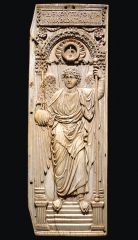
|
Saint Michael the Archangel early sixth century *EARLY BYZANTINE |
|

|
Hagia Sophia Anthemius of Tralles and Isidorus of Miletus 532-537 *EARLY BYZANTINE |
|
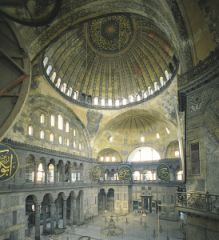
|
Interior of Hagia Sophia Anthemius of Tralles and Isidorus of Miletus 532-537 *EARLY BYZANTINE |
|
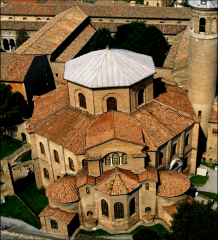
|
San Vitale 526-547 *EARLY BYZANTINE |
|
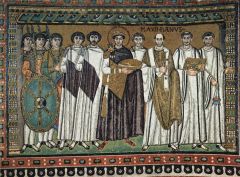
|
Justinian, Bishop Maximianus, and attendants (mosaic on north wall of apse in San Vitale) ca. 547 *EARLY BYZANTINE |
|
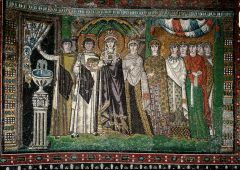
|
Theodora and attendants (mosaic on south wall of apse in San Vitale) ca. 547 *EARLY BYZANTINE |
|
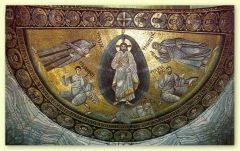
|
Transfiguration of Jesus (apse mosaic, Church of the Virgin) ca. 548-565 *EARLY BYZANTINE |
|
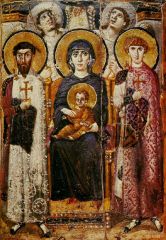
|
Virgin and Child between Saints Theodore and George sixth or early seventh century *EARLY BYZANTINE |
|
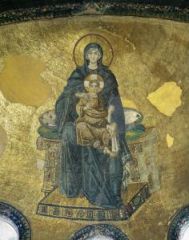
|
Virgin and Child enthroned ca. 867 *MIDDLE BYZANTINE |
|
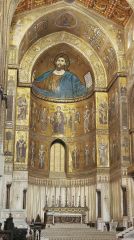
|
Pantokrator, Theotokos and Child, angels, and saints (apse mosaic in Monreale cathedral) c. 1180 - 1190 *MIDDLE BYZANTINE |
|

|
David Composing the Psalms ca. 950 - 970 *MIDDLE BYZANTINE |
|
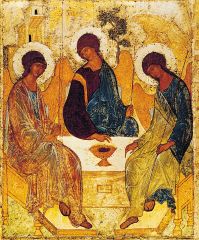
|
Three Angels (Old Testament Trinity) Andrei Rublyev ca. 1410 *LATE BYZANTINE |
|
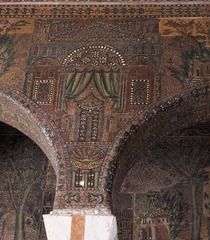
|
Detail of a mosaic in the courtyard arcade of the Great Mosque 706 - 715 *EARLY ISLAMIC |
|
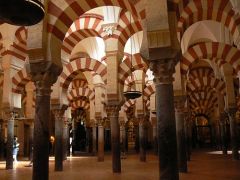
|
Prayer hall of the Mezquita (Great Mosque) ca. 8th to 10th centuries *EARLY ISLAMIC |
|
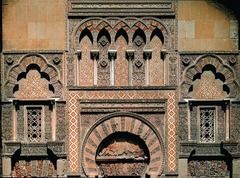
|
Detail of the upper zones of the east gate of the Mezquita (Great Mosque) 961 - 965 *EARLY ISLAMIC |
|
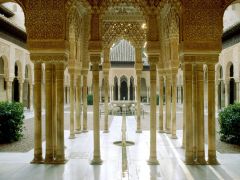
|
Court of the Lions 1354 - 1391 *LATER ISLAMIC |
|
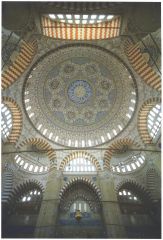
|
Interior of the Mosque of Selim II Sinan 1568 - 1575 *LATER ISLAMIC |
|
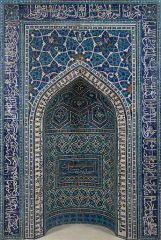
|
Mihrab, from the Madrasa Imami ca. 1354 *LATER ISLAMIC |
|
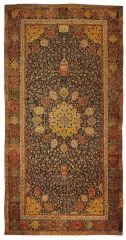
|
Carpet from the funerary mosque of Shaykh Safi al-Din Maqsud of Kashan 1540 *LATER ISLAMIC |
|
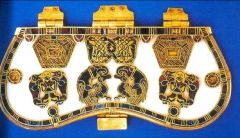
|
Purse cover from the Sutton Hoo ship burial ca. 625 *ART OF THE WARRIOR LORDS |
|
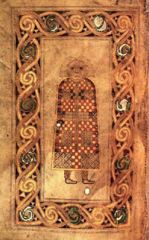
|
Man (symbol of St. Matthew) folio 21 verso of the "Book of Durrow" ca. 660-680 *HIBERNO-SAXON ART |
|
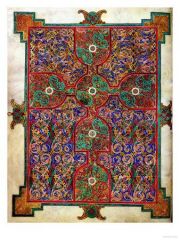
|
Cross-inscribed carpet page, folio 26 verso of the "Lindesfarne Gospels" ca. 698-721 *HIBERNO-SAXON ART |
|
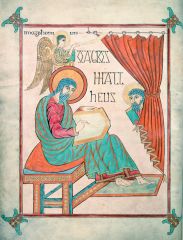
|
Saint Matthew, folio 25 verso of the "Lindesfarne Gospels" ca. 698-721 *HIBERNO-SAXON ART |
|
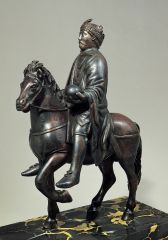
|
Equestrian portrait of Charlemagne or Charles the Bald ca. 9th century *CAROLINGAN ART |
|

|
Saint Matthew, folio 15 recto of the "Coronation Gospels" ("Gospel Book of Charlemagne") ca. 800-810 *CAROLINGAN ART |
|

|
Saint Matthew, folio 18 verso of the "Ebbo Gospels" ca. 816-835 *CAROLINGAN ART |
|
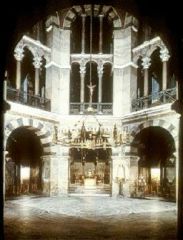
|
Interior of the Palatine Chapel of Charlemagne 792-805 *CAROLINGAN ARCHITECTURE |
|
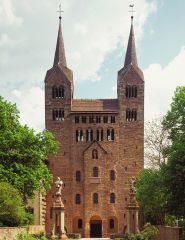
|
Westwork of the abbey church 873-885 *CAROLINGAN ARCHITECTURE |
|
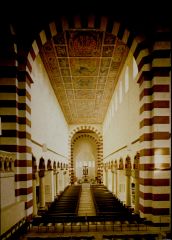
|
Nave of St. Michael's 1001-1031 *OTTONIAN ARCHITECTURE |
|

|
God accusing Adam and Eve (detail of the left door of Saint Michael's) 1015 *OTTONIAN ART
|
|
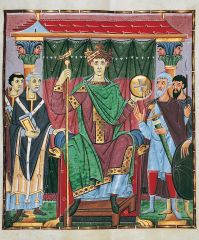
|
Otto III enthroned, folio 24 recto of the "Gospel Book of Otto III" 997-1000 *OTTONIAN ART |
|
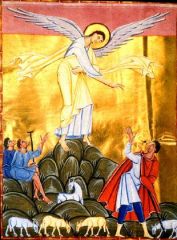
|
Annunciation to the Shepherds, folio in the "Lectionary of Henry II" 1002-1014 *OTTONIAN ART |
|

|
Last Judgement, west tympanum of Saint-Lazare Gislebertus 1120-1135 *ROMANESQUE FRANCE AND NORTHERN SPAIN |
|
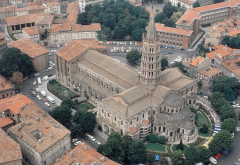
|
Aerial view of Saint-Sernin ca. 1070-1120 *ROMANESQUE FRANCE AND NORTHERN SPAIN |
|

|
Christ in Majesty, relief in the ambulatory of Saint-Sernin Bernardus Gelduinus ca. 1096 *ROMANESQUE FRANCE AND NORTHERN SPAIN |
|
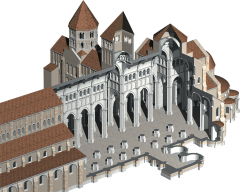
|
Restored view of the third abbey church (Cluny III) 1088-1130 *ROMANESQUE FRANCE AND NORTHERN SPAIN |
|
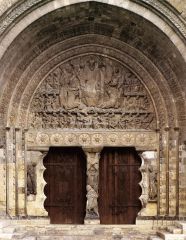
|
General view of the south portal of Saint-Pierre ca. 1115-1135 *ROMANESQUE FRANCE AND NORTHERN SPAIN |
|
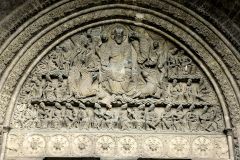
|
Detail of Saint-Pierre tympanum with "Second Coming of Christ" ca. 1115-1135 *ROMANESQUE FRANCE AND NORTHERN SPAIN |
|
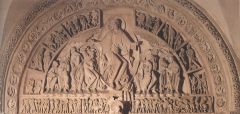
|
"Pentecost" and "Mission of the Apostles", tympanum of the center portal of the narthex of La Madeleine 1120-1132 *ROMANESQUE FRANCE AND NORTHERN SPAIN |
|
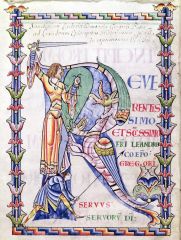
|
Initial R with knight fighting dragons, folio 4 verso of the "Moralia in Job" ca. 1115-1125 *ROMANESQUE FRANCE AND NORTHERN SPAIN |
|
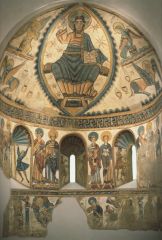
|
"Christ in Majesty" apse of Santa Maria de Mur mid 12th century *ROMANESQUE FRANCE AND NORTHERN SPAIN |
|
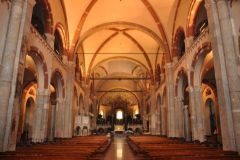
|
Interior of Sant'Ambrogio late 11th to early 12th century *ROMANESQUE HOLY ROMAN EMPIRE |
|
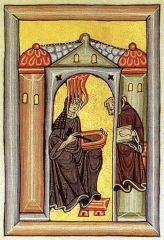
|
Hildegard reveals her visions, detail of a facsimile of a lost folio in the Rupertsberger "Scivias" ca. 1050-1079 *ROMANESQUE HOLY ROMAN EMPIRE |
|
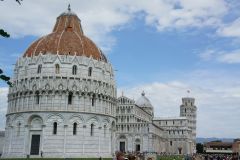
|
Pisa Cathedral complex 1068-1174 *ROMANESQUE ITALY |
|

|
West facade of Saint-Etienne 1067 *ROMANESQUE NORMANDY AND ENGLAND |
|

|
Interior of Durham Cathedral ca. 1093 *ROMANESQUE NORMANDY AND ENGLAND |
|
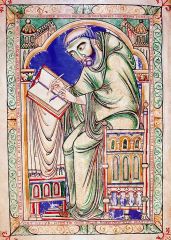
|
Eadwine the Scribe at work, folio 283 verso of the "Eadwine Psalter" ca. 1160 - 1170 *ROMANESQUE NORMANDY AND ENGLAND |
|
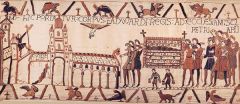
|
Funeral procession to Westminster Abbey, detail of the "Bayeux Tapestry" ca. 1070-1080 *ROMANESQUE NORMANDY AND ENGLAND |
|
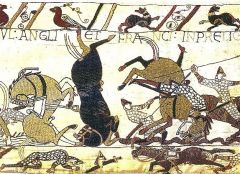
|
Battle of Hastings, detail of the "Bayeux Tapestry" ca. 1070-1080 *ROMANESQUE NORMANDY AND ENGLAND |
|
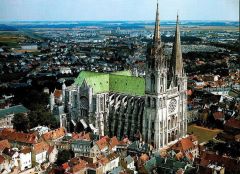
|
Aerial view of Chartres Cathedral rebuilt after 1194 *GOTHIC FRANCE |
|
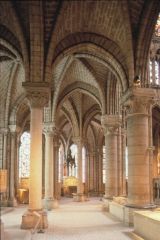
|
Ambulatory and radiating chapels, abbey church of Saint-Denis 1140-1144 *GOTHIC FRANCE |
|
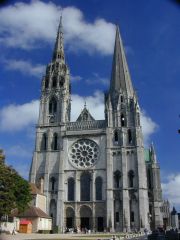
|
West facade, Chartres Cathedral ca. 1145-1155 *GOTHIC FRANCE |
|
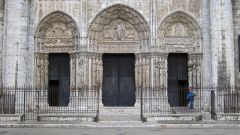
|
Royal portal, west facade, Chartres Cathedral ca. 1145-1155 *GOTHIC FRANCE |
|
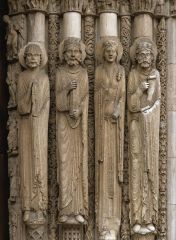
|
Old Testament kings and queen, jamb statues, right side of the central doorway of the Royal Portal, Chartres Cathedral ca. 1145-1155 *GOTHIC FRANCE |
|

|
Rose window and lancets, north transept, Chartres Cathedral ca. 1220 *GOTHIC FRANCE |
|
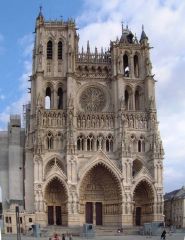
|
West facade of Amiens Cathedral Robert de Luzarches, Thomas de Cormont, and Renaud de Cormont ca. 1220 *GOTHIC FRANCE |
|

|
West facade of Reims Cathedral Gaucher de Reims and Bernard de Soissons ca. 1225-1290 *GOTHIC FRANCE |
|
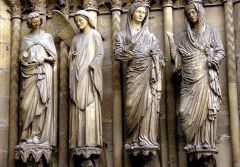
|
"Annunciation and Visitation" jamb statues on the right side of the central doorway of the west facade, Reims Cathedral ca. 1230-1255 *GOTHIC FRANCE |
|
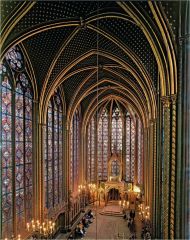
|
Interior of the upper chapel, Sainte-Chapelle ca. 1243-1248 *GOTHIC FRANCE |
|

|
Virgin and Child (Virgin of Paris) early 14th century *GOTHIC FRANCE |
|

|
West facade of Saint-Maclou ca. 1500-1514 *GOTHIC FRANCE |
|
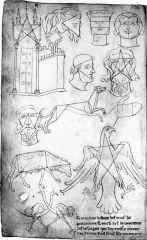
|
Figures based on geometric shapes, folio 18 verso of a sketchbook Villard de Honnecourt ca. 1220-1235 *GOTHIC FRANCE
|
|
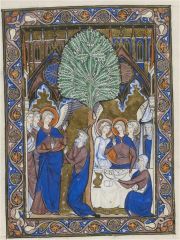
|
Abraham and the Three Angels, folio 7 of the "Psalter of Saint Louis" 1253-1270 *GOTHIC FRANCE |
|
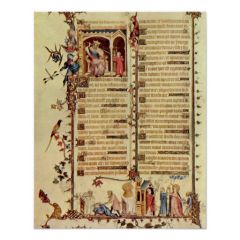
|
David before Saul, folio 24 verso of the "Belleville Breviary" Jean Pucelle ca. 1325 *GOTHIC FRANCE |
|

|
Aerial view of Salisbury Cathedral 1220-1258 *GOTHIC ENGLAND |
|
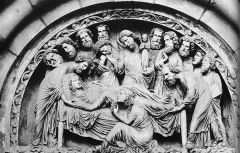
|
"Death of the Virgin", tympanum of the left doorway of the south transept, Strasbourg Cathedral ca. 1230 *GOTHIC HOLY ROMAN EMPIRE |
|

|
Ekkehard and Uta, statues in the west choir, Naumburg Cathedral Naumburg Master ca. 1249-1255 *GOTHIC HOLY ROMAN EMPIRE |
|
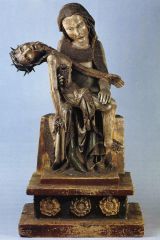
|
Rottgen Pieta ca. 1300-1325 *GOTHIC HOLY ROMAN EMPIRE |
|
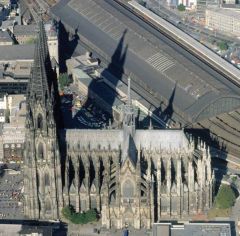
|
Aerial view of Cologne Cathedral Gerhard of Cologne ca. 1248 *GOTHIC HOLY ROMAN EMPIRE
|
|
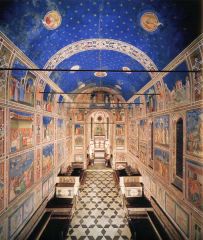
|
Interior of the Arena Chapel (Capella Scrovegni) Giotto di Bondone 1350-1360 *13TH CENTURY |
|
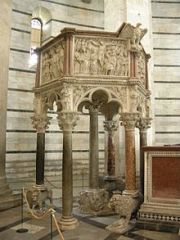
|
Pulpit of the baptistery Nicola Pisano 1259-1260 *13TH CENTURY |
|
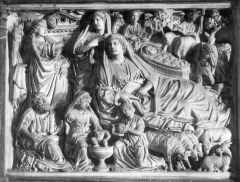
|
"Annunciation, Nativity, and Adoration of the Shepherds" relief panel on the baptistery pulpit 1259-1260 *13TH CENTURY |
|

|
Saint Francis Altarpiece Bonaventura Berlinghieri 1235 *13TH CENTURY |
|

|
Madonna Enthroned with Angels and Prophets Cimabue ca. 1280-1290 *13TH CENTURY |
|
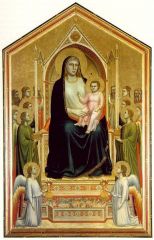
|
Madonna Enthroned Giotto di Bondone ca. 1310 *14TH CENTURY |
|
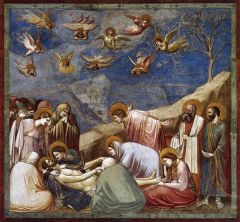
|
Lamentation Giotto di Bondone ca. 1305 *14TH CENTURY |
|
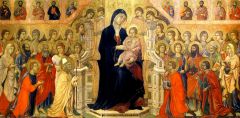
|
Virgin and Child Enthroned with Saints Duccio di Buoninsegna ca. 1308-1311 *14TH CENTURY |
|
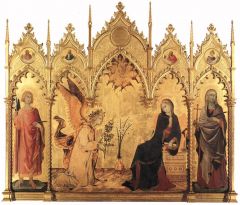
|
"Annunciation" altarpiece Simone Martini and Lippo Memmi 1333 *14TH CENTURY
|
|
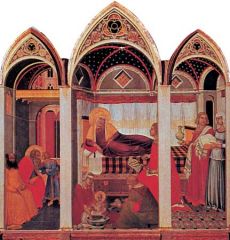
|
Birth of the Virgin Pietro Lorenzetti 1342 *14TH CENTURY |
|
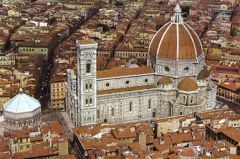
|
Aerial view of Santa Maria del Fiore Arnolfo di Cambio 1334 *14TH CENTURY |
|
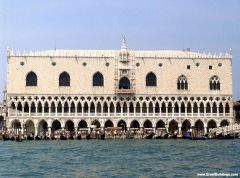
|
Doge's Palace, Venice ca. 1340-1345 *14TH CENTURY |
|
|
Rotulus |
Thee manuscript scroll used by egyptians greeks etruscans and romans,predecessor of the Codex |
|
|
Impost-Block |
The uppermost block of a wall or pier beneath the springing of an arch |
|
|
icon |
a portrait or image especially in Byzantine churches, a panel with a painting of sacred personages that are objects of veneration. |
|
|
cloisonné |
A decorative metalwork technique employing Cloisons; also decorative brick work in later Byzantine architecture |
|
|
Cloison |
French- "partition" a cell made of metal wire or a narrow metal strip soldered edge up to a metal base to hold enamel, semi precious stones, peices of colored glass, or glass paste fired to resemble sparkling jewels. |
|
|
scriptoria |
The writing studio of a monastery
|
|
|
crusades |
In medieval Europe, armed pilgrimages aimed at recapturing the holy land from the muslims |
|
|
Hildegarde of Bingen |
German nun, poet, and composer. Revered as a visionary during her own lifetime, she set her poems to musicand also wrote works on medicine and natural history. |
|
|
apse |
a recess usually semi-circular, in the wall of a buildng, commonly found at the east end of a church |
|
|
trumeau |
In church arch., the pillar or center post supporting the lintel in the middle of the doorway. |
|
|
Gothic |
Originally a derogatory term name after the goths, used to describe the history, culture and art of western Europe in the 12th to 14th century. Typically divided into early, high and late. |
|
|
clerestory |
a fenestrated part of a building that rises above the roofs of the other parts. In roman basilicas and medieval churches, clerestories are the windows that form the nave's uppermost level below the timber ceiling or the vaults. |
|
|
St. Thomas Aquinas |
Italian theologian and Doctorof the Church who is remembered for his attempt to reconcile faith and reason ina comprehensive theology; presented philosophical proofs of the existence ofGod (1225-1274) |
|
|
Court Style |
Earliest phase of the Rayonnant style of French Gothic, closely associated with the reign of King Louis IX (1227–70). It was characterized by the dissolution of walls in favour of huge areas of windows subdivided by thin, wire-like tracery, the piercing of the wall of the triforium-gallery with windows, and the introduction of masses of colonnettes corresponding to the ribs in the vault. |
|
|
breviary |
A christian religious book of selected daily prayers and psalms |
|
|
trefoil-arch |
a triple loped arch 402 |
|
|
punchwork |
tooled decorative work in gold leaf 412 |
|
|
mandorla |
an almond shaped nimbus (a halo surrounding head) surrounding the figure of christ or other sacred figure. |
|
|
chi-rho |
a monogram of chi (Χ) and rho (Ρ) as the first two letters of Greek Khristos Christ, used as a Christian symbol. |
|
|
iconoclasm |
the destruction of religious or sacred images. In byzantium the period from 726 to 843 when there was an imperial ban on such images. The destroyers of images were known as iconoclasts. Those who apposed were known as iconophiles 257, 269, 543, 652 |
|
|
Hiberno-Saxon |
an art style that flourished in the monasteries of the British Isles in the early middle ages. Also called insular 311 |
|
|
westwork |
-german, "western entrance structure" the facade and towers at the western end of medieval church. 323 |
|
|
reliquary |
a container for holding relics 334,336, 430 |
|
|
relic |
the body parts, clothing, or objects associated with a holy figure such as christ. 336 |
|
|
Bishop Odo |
French pope from 1088 to 1099 whose sermons called for the First Crusade(1042-1099) |
|
|
transept |
the part of a church with an axis that crosses the nave at a right angle 243 564 |
|
|
voissoir |
a wedge shaped stone block used in the construction of a true arch. the central voussoir, which sets the arch is called the keystone 344 |
|
|
tribune gallery |
In church arch.m a gallery over the inner aisle flanking the nave |
|
|
Abbot Suger |
French cleric and statesman, abbot of Saint-Denis from 1122, minister of kings LouisVI and Louis VII. Born into a peasant family and educated at the abbey of Saint-Denis, Suger was noted for hisfinancial ability and his talent for conciliation. In 1147, Louis VII left on crusade and appointed a council of regency, ofwhich Suger was the leading member. During his administration (1147–49) Suger succeeded in maintaining peace athome and in raising funds to meet the king's expenses. He liberated the abbey at Saint-Denis from the tributeformerly paid to exploiters, recovered alienated properties, built a new church, and enriched it with works of art; thechurch is sometimes considered the first great work of Gothic architecture |
|
|
Rayonnant |
The "radiant" style of gothic architecture, dominant in the second half of the 13th century and associated with the french royal court of Louis IX at Paris |
|
|
s-curve |
contraposto |
|
|
Flamboyant |
a late french gothic style of architecture superseding Rayonnant style and named for the flame like appearance of it's pointed bar tracery |
|
|
quatrefoil |
a shape or plan in which the parts assume the form of a cloverleaf 419 |
|
|
International Style |
a style of 14th and 15 century painting begun by simone martini who adapted the french gothic manner to seiense art fused with influences from northern europe. this style appealed to the aristocracy because of its brillinat color, lavish costumes etc. |
|
|
pendentive |
a concave triangular section of a hemisphere, four of which provide the transition from a square area to the circular base of a covering dome. Although pendentive appear to be hanging, pendant, from the dome, they in fact support it. 262 |
|
|
caesaropapism |
is the idea of combining the power of secular government with the religious power, or making it superior to the spiritual authority of the Church; especially concerning the connection of the Church with government. |
|
|
Carolingian |
pertaining to the empire of Charlemagne and his successors 317 |
|
|
alternate support system |
In church architecture, the use of alternating wall suports in the nave, usually piers and columns or compound piers of alternating form 324 |
|
|
Romanesque |
"roman-like" a term used to describe the hisroty, culture and art of medieval western europe from ca. 1050 to ca. 1200. (333,413) |
|
|
façade |
usually the front of a building also the other sides when the are emphasized architecturally 412 |
|
|
ambulatory |
a covered walkway, outdoors (as in a church cloister) or indoors; especially the passageway around the apse and the choir of a church. 244 430 |
|
|
William the Conqueror |
(1027-1087) the king of England from 1066 until his death. He was also called William I. William was the Duke of Normandy (in northern France), and became king of England by defeating King Harold at the Battle of Hastings in 1066. His arrival brought great changes in English society, and people see it as the end of the Anglo-Saxon period and the beginning of the Middle Ages. |
|
|
flying buttress |
an exterior masonry structure that opposes the lateral thrust of an arch or a vault. A flying buttress consists typically of an inclined member carried on an arch or a series of arches and a solid buttress to which it transmits lateral thrust. |
|
|
Summa Theologica |
a compendium of theology, philosophy, or canon law written by St Thomas Aquinas between 1265 and 1274 |
|
|
tracery |
ornamental stonework for holding stained glass in place, characteristic of Gothic cathedrals. In plate tracery the glass fills only the "punched holes" in the heavy ornamental stonework. In bar tracery the stained glass windows fill almost the entire opening and the stonework is unobstrusive |
|
|
Louis IX (St. Louis) |
king of France and son of Louis VIII; he led two unsuccessful Crusades;considered an ideal medieval king (1214-1270) |
|
|
maniera greca |
itallian- "greek manner" the Italo-Byzantine painting style of painting of the 13th century |
|
|
altarpiece |
a panel, painted or sculpted, situated above and behind an altar. 392, 404 |
|
|
squinch |
an architectural device used as a transition form a square to a polgonal or circular base for a dome. It may be composed of lintels, corbels or arches. |
|
|
theotokos |
-greek, "she who bore god" the virgin mary the mother of jesus 245 257 |
|
|
Animal Style |
a medieval art form in which animals are depicted in a stylized and often complicated pattern, usually seen fighting with one another |
|
|
Ottonian |
pertaining to the empire of Otto I and his successors 324 |
|
|
pilgrimage |
a journey, especially a long one, made to some sacred place as an actof religious devotion |
|
|
Gislebertus |
sometimes "of Autun" (flourished in the 12th century), was a French Romanesque sculptor, whose decoration (about 1120-1135) of the Cathedral of Saint Lazare atAutun, France - consisting of numerous doorways, tympanums, and capitals - represents some of the most original work of the period. |
|
|
nave |
the central area of an ancient Roman basilica or of a church, demacrated from the aisles by piers of columns |
|
|
tympanum |
The space enclosed by a lintel and an arch over a doorawy 344 538 |
|
|
portal |
a doorway, gate, or other entrance, especially a large and elaborate one. |
|
|
triforium
|
in a gothic cathedral the blind arcaded gallery below the clerestory; occasionally, the arcades are filled with stained glass 370 373 |
|
|
Scholasticism |
the gothic school of philosophy in which scholars applied Aristotle's system of rational inquiry to the interpretation of religious beliefs, 372 |
|
|
mullion |
a vertical member that divides a window or that separates one window from another 381 |
|
|
ars de geometria |
art of geometry. especially connected to the divine |
|
|
Italo-Byzantine |
Style of art, which began to explore a classical or natrualistic way of depicting, objects but still retained many Byzantine. |
|
|
predella |
the narrow ledge on which an altar piece rests on an altar 411 |

